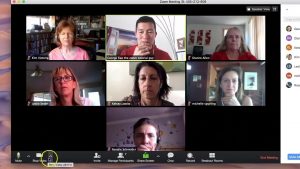 This is fair use’s time to shine. The right to employ unlicensed copyright materials–under some circumstances—may be even busier than home-schooling, at-work parents at the moment. In fact,many remotely-held school and work activities couldn’t happen without it.
This is fair use’s time to shine. The right to employ unlicensed copyright materials–under some circumstances—may be even busier than home-schooling, at-work parents at the moment. In fact,many remotely-held school and work activities couldn’t happen without it.
Fair use is making it possible for teachers to read books to students, for librarians to make films and textbooks available to learners and researchers and to read to little ones during storytime, for employees to use copyrighted imagery in their work presentations, and much, much more.
Fair use makes learning possible.
Fair use is the part of U.S. copyright law that most broadly and flexibly ensures that culture in our living memory can still be accessed, in order to do something new with it. (That is, not just take it for its marketplace purpose.) Judges ask whether your use of copyrighted material is for a “transformative” purpose—that is, whether you’re using it for some new purpose, which would make your work a new cultural act, and whether you’re using the appropriate amount for that new purpose. (That could be the whole thing, depending on your new cultural expression.)
Teachers, librarians and students, both in K-12 and higher education, have suddenly had a lot of new questions about  copyright. That’s because in a face-to-face, four-walls classroom situation, they both have expansive rights to use copyrighted material. And they’re used to that. But they lose a lot of those rights in an online environment, even on an electronic course platform like Canvas, Moodle or Blackboard, not to mention Zoom. And that’s where fair use comes to the rescue.
copyright. That’s because in a face-to-face, four-walls classroom situation, they both have expansive rights to use copyrighted material. And they’re used to that. But they lose a lot of those rights in an online environment, even on an electronic course platform like Canvas, Moodle or Blackboard, not to mention Zoom. And that’s where fair use comes to the rescue.
What would you like to do?
Would you like to figure out what’s OK in terms of using copyrighted materials to teach with online? Here’s a link that aggregates resources that academic librarians have been assembling since the day we all went home to work.
Would you like to keep up with what experts on the topic are writing and sharing? Check out Harvard’s Kyle Courtney’s website.
How about if you’re a public librarian, and want to know if online storytime is OK? Try this. As the American Library Association’s Carrie Russell says, “It’s fair use, folks.” But read the whole blog post before you act.
 And of course, the Center for Media & Social Impact’s suite of fair use codes of best practices—for filmmakers, media literacy teachers, online videomakers, communication researchers, film teachers and scholars, journalists, librarians, archivists, software preservations, dance archivists, online courseware preparers, visual artists, and more—provide durable, proven advice for a multitude of online and in-person situations.
And of course, the Center for Media & Social Impact’s suite of fair use codes of best practices—for filmmakers, media literacy teachers, online videomakers, communication researchers, film teachers and scholars, journalists, librarians, archivists, software preservations, dance archivists, online courseware preparers, visual artists, and more—provide durable, proven advice for a multitude of online and in-person situations.
Stretching out.
Some folks are flexing their fair use muscles, and their uses will be closely watched. If you’re a member of certain academic communities and the library is closed, the members of Hathitrust have a limited solution for you. They’ll let you “take out” a digital copy–but only one copy can be loaned at a time. That is the way the Internet Archive used to “loan” out its 1.4M digital collection, until March, when it opened the collection up more widely to the general public (and to much huffing from publishers), on a temporary basis for the crisis.
You might have heard that some publishers are opening up their resources for the crisis. That’s great, and here’s a partial list. But you also don’t need anyone’s permission to appropriate employ fair use to get work done.
When this emergency is over, what people have learned about putting fair use to work will stand them in good stead. Because, as some of my colleagues make clear in this document bout reading aloud online, fair use isn’t just for emergencies. And people need to learn online as much as in person.
